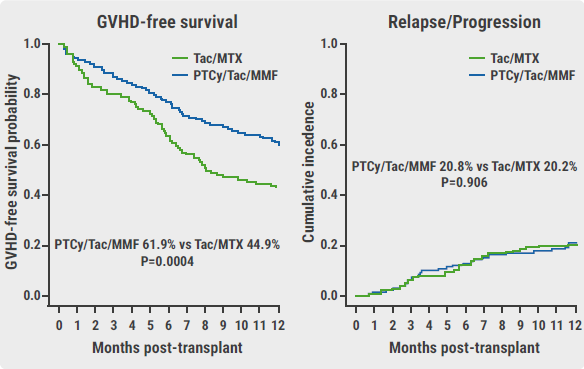https://doi.org/10.55788/ed3ec8ea
The UKALL 2011 trial (ISRCTN64515327) included children and young adults up to 25 years of age with ALL. Investigated were the difference between a short (14 days) versus a standard (28 days) induction course of dexamethasone, the CNS relapse risk for high-dose methotrexate compared with a standard interim maintenance regimen, and the difference between the effect of vincristine/dexamethasone pulses or no pulses on bone marrow relapse rate. At ASH 2017, the results of the dexamethasone induction courses were presented [1]. At ASH 2022, Ms Amy Kirkwood (University College London, UK) presented the maintenance results [2].
In total, 1,570 participants, receiving a backbone therapy according to the risk group they were stratified to, were randomised to 1 of 4 maintenance arms:
- High-dose methotrexate with pulses
- High-dose methotrexate without pulses
- Standard interim maintenance with pulses
- Standard interim maintenance without pulses
After a median follow-up of 72 months, there was no difference between high-dose methotrexate and standard interim maintenance with regard to CNS relapse (HR 0.99; 95% CI 0.65–1.51; P=0.97), with 5-year rates of 5.6% for both treatment regimens. Interestingly, participants who received a short course of induction dexamethasone followed by high-dose methotrexate and no pulses had an inferior event-free survival compared with participants who received short-duration induction dexamethasone followed by either high-dose methotrexate with pulses or standard interim maintenance with or without pulses (survival rate 75.9% vs 83.2–86.0%; P-value for interaction=0.006).
Furthermore, ‘no pulses’ was non-inferior to ‘pulses’ regarding bone marrow relapse rates (HR 1.22; 95% CI 0.89–1.67). The corresponding 5-year bone marrow relapse rates were 12.2% for participants who did not receive pulses and 10.2% for those who did receive pulses. Ms Kirkwood added that the 5-year event-free survival rate was slightly higher in participants who received pulses than those who did not (86.0% vs 81.7%; P=0.010).
In conclusion, high-dose methotrexate maintenance therapy did not reduce the risk for CNS relapse in young patients with ALL enrolled in the UKALL 2011 trial. Omitting pulses did not result in a higher rate of bone marrow relapse in this population.
- Goulden NJ, et al. Blood. 2017;130(supplement_1):141.
- Kirkwood AA, et al. High Dose Methotrexate Does Not Reduce the Risk of CNS Relapse in Children and Young Adults with Acute Lymphoblastic Leukaemia and Lymphoblastic Lymphoma. Results of the Randomised Phase III Study UKALL 2011. Abstract 214, ASH 64th Annual Meeting, 10–13 December 2022, New Orleans, LA, USA.
Copyright ©2023 Medicom Medical Publishers
Posted on
Previous Article
« ASCO GI 2023 Highlights Podcast Next Article
Blinatumomab candidate for standard-of-care in newly diagnosed B-ALL »
« ASCO GI 2023 Highlights Podcast Next Article
Blinatumomab candidate for standard-of-care in newly diagnosed B-ALL »
Table of Contents: ASH 2022
Featured articles
Acute Lymphoblastic Leukaemia
Blinatumomab candidate for standard-of-care in newly diagnosed B-ALL
High-dose methotrexate or standard interim maintenance in young patients with ALL?
Acute Myeloid Leukaemia
Excellent results for triplet regimen in FLT3-mutated AML
MRD by qPCR prognostic of outcomes in venetoclax-treated NPM1-mutated AML
Promising results for triplet therapy with magrolimab in AML
Should we use intensive chemotherapy prior to allo-HCT in relapsed/refractory AML?
Chronic Leukaemia
Zanubrutinib wins battle of BTK inhibitors in relapsed or refractory CLL/SLL
Ibrutinib plus venetoclax displays long-term benefits in CLL
Multiple Myeloma
Talquetamab further investigated in heavily pre-treated MM after promising phase 2 data
Promising results of elranatamab for MM in phase 2 MagnetisMM-3 trial
Deep and durable responses for quadruple therapy in smouldering MM
Ultra-sensitive MRD assessment in MM with BloodFlow
CAR-Hematotox score proves useful in relapsed/refractory MM
Head-to-head: VMP versus Rd in transplant-ineligible MM
Lymphoma
Ibrutinib added to ASCT improves clinical outcomes in mantle cell lymphoma
High-dose chemotherapy plus ASCT superior to standard immuno-chemotherapy in primary CNS lymphoma
Odronextamab has considerable anti-tumour effects in relapsed/refractory diffuse large B-cell lymphoma and follicular lymphoma
Excellent results for AFM13-complexed NK cells in CD30-positive lymphoma
CAR-Hematotox score predicts toxicity, infections, and clinical outcomes in MCL
Myeloproliferative Neoplasms
Efgartigimod successful in immune thrombocytopenia
INCA033989: novel investigational agent for CALR-mutated MPN
Ruxolitinib mediates clonal evolution of RAS pathway mutations in MPN
Immune Thrombocytopenia
Long-term risk for haematologic disease in persistent, isolated mild thrombocytopenia
Various Topics
C1 inhibitor deficiency linked to thrombosis
Durable responses to gene therapy in haemophilia A
Long-term benefits from beti-cel in transfusion-dependent β-thalassaemia
Neutrodiet: non-restricted diet is the preferred option after SCT
Iptacopan offers solution for patients with PNH and residual anaemia after standard-of-care
Novel therapy may replace standard-of-care prophylaxis for GVHD
LMWH does not result in higher live birth rates in women with inherited thrombophilia
Related Articles

February 20, 2023
Novel therapy may replace standard-of-care prophylaxis for GVHD
February 20, 2023
C1 inhibitor deficiency linked to thrombosis
© 2024 Medicom Medical Publishers. All rights reserved. Terms and Conditions | Privacy Policy

